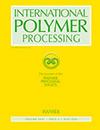Visualization analysis of temperature distribution in the cavity of conventional PPS and high-thermal-conductivity PPS during the filling stage of injection molding
IF 1.9
4区 工程技术
Q4 ENGINEERING, CHEMICAL
引用次数: 1
Abstract
Abstract As a highly thermally conductive PPS that is lightweight and has excellent heat dissipation is expected to be applied in various products, its peculiar filling behavior can cause molding defects such as short shots and surface cracks. To address these challenges, it is important to elucidate the filling behavior and clarify the effects of cavity shape and molding conditions. Thus, we intend to visualize the filling behavior of the high-thermal-conductivity PPS. To achieve this goal, we develop an in-process visualization system to reveal both the thermal and kinetic behaviors of the resin while it fills the cavity. In the system, a sapphire prism glass is utilized in the mold for visualization because it exhibits high strength, high heat conduction, and high infrared transmittance. A high-speed visible camera for kinetic behavior and an infrared camera for thermal behavior are utilized. With the developed system, we successfully obtained for the first time the filling behavior of high-thermal-conductivity PPS. Visualization experiments prove that the temperature of the conventional PPS gradually decreases from the tip to the rear of the flow. However, the temperature of the high-thermal-conductivity PPS drops sharply from the tip of the flow to the rear, and breakage at the flow front near the cavity wall is generated. Our interpretation is that the flow front near the cavity wall can be easily broken when it is stretched, because the ductility of the high-thermal-conductivity PPS largely decreases because of the rapid temperature drop. To suppress the formation of this breakage, we modify the cavity shape and molding conditions, and verify its suppression effect.常规PPS和高热导率PPS在注射成型填充阶段腔体温度分布的可视化分析
摘要作为一种重量轻、散热性好的高导热PPS,其独特的填充行为会导致短射和表面裂纹等成型缺陷,有望应用于各种产品中。为了应对这些挑战,阐明填充行为并阐明腔体形状和成型条件的影响是很重要的。因此,我们打算可视化高导热性PPS的填充行为。为了实现这一目标,我们开发了一个过程可视化系统,以显示树脂填充空腔时的热行为和动力学行为。在该系统中,蓝宝石棱镜玻璃被用于模具中进行可视化,因为它表现出高强度、高导热性和高红外透射率。使用用于动力学行为的高速可见照相机和用于热行为的红外照相机。利用所开发的系统,我们首次成功地获得了高导热PPS的填充行为。可视化实验证明,传统PPS的温度从流动的尖端到后部逐渐降低。然而,高热导率PPS的温度从流的尖端向后急剧下降,并且在靠近腔壁的流前部产生破裂。我们的解释是,当空腔壁附近的流动前沿被拉伸时,它很容易被破坏,因为高导热PPS的延展性由于温度的快速下降而大大降低。为了抑制这种破损的形成,我们修改了腔体形状和成型条件,并验证了其抑制效果。
本文章由计算机程序翻译,如有差异,请以英文原文为准。
求助全文
约1分钟内获得全文
求助全文
来源期刊

International Polymer Processing
工程技术-高分子科学
CiteScore
2.20
自引率
7.70%
发文量
62
审稿时长
6 months
期刊介绍:
International Polymer Processing offers original research contributions, invited review papers and recent technological developments in processing thermoplastics, thermosets, elastomers and fibers as well as polymer reaction engineering. For more than 25 years International Polymer Processing, the journal of the Polymer Processing Society, provides strictly peer-reviewed, high-quality articles and rapid communications from the leading experts around the world.
 求助内容:
求助内容: 应助结果提醒方式:
应助结果提醒方式:


